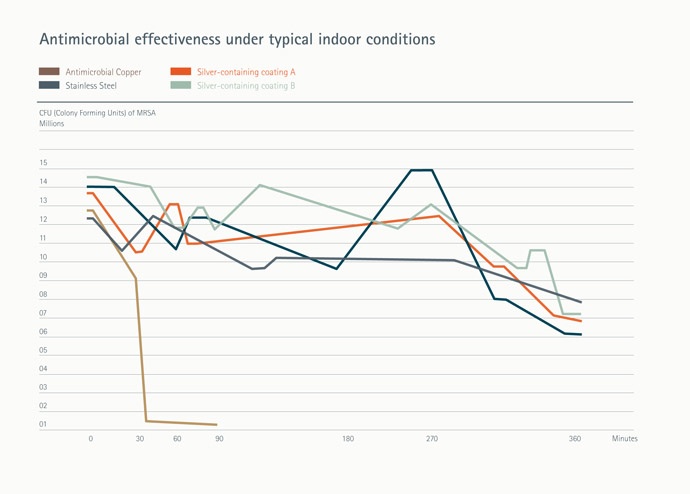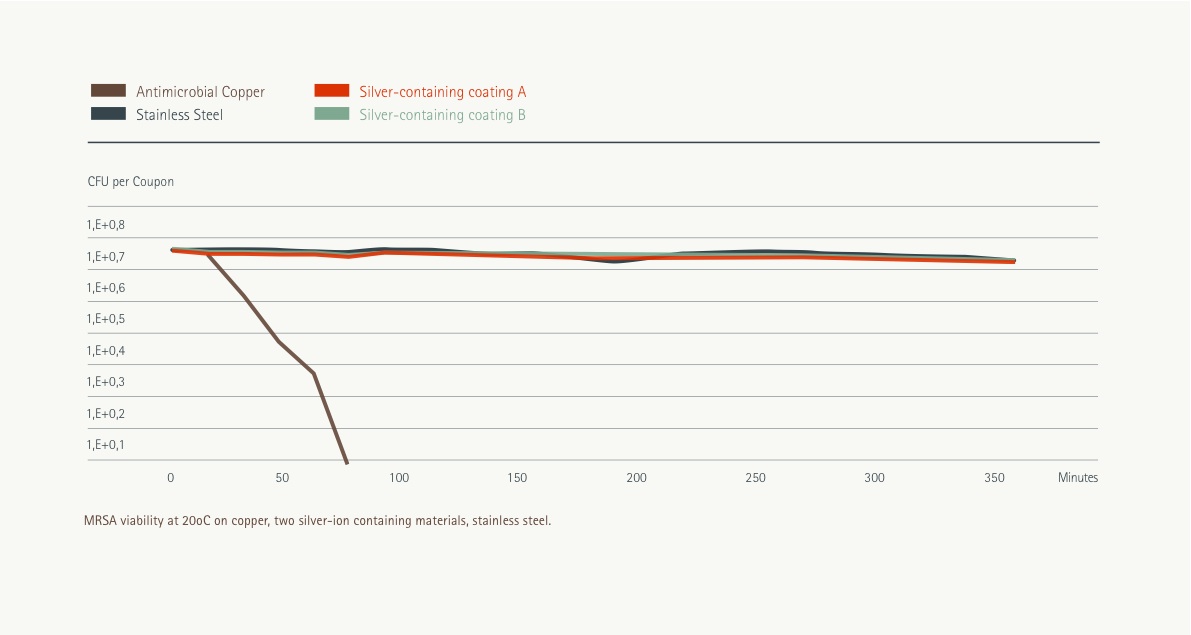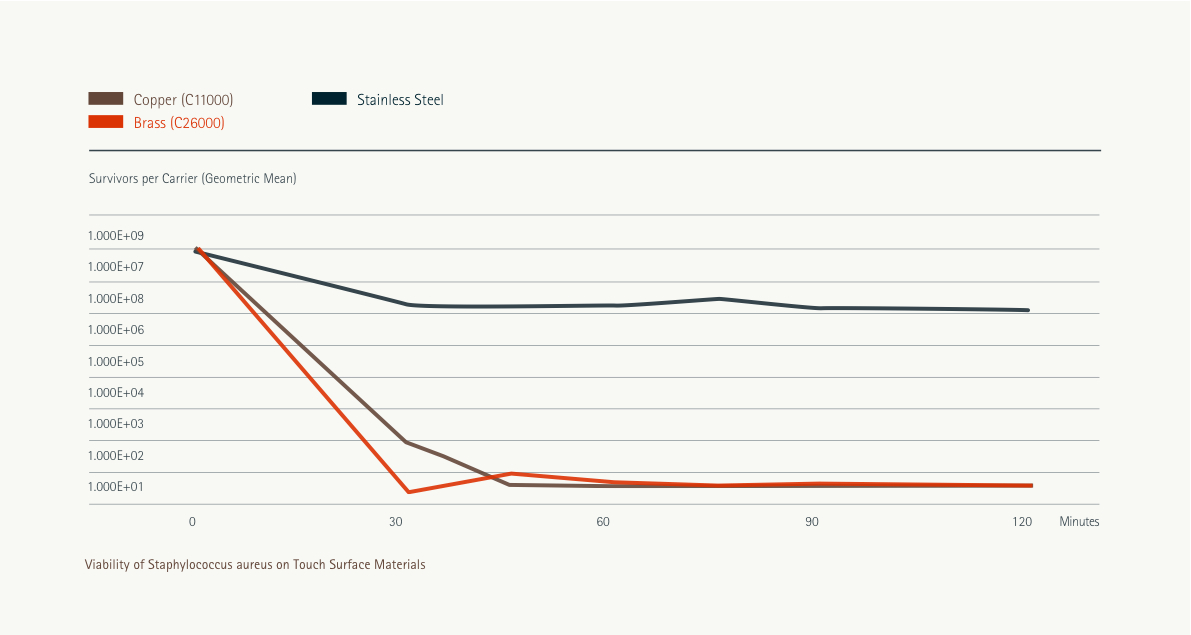Antimicrobial Copper is the most effective touch surface material in the fight against pathogenic microbes, killing greater than 99.9% of bacteria* within 2 hours of exposure. No other material, such as silver-containing coatings, comes close.
Laboratory research on the efficacy of Antimicrobial Copper has been carried out and verified at institutions around the world, including the UK (Aston University, University of Southampton, Kingston University), US, South Africa, Germany, Greece and Japan. Testing has been conducted under conditions simulating typical indoor conditions. Results have been peer reviewed and published.
Kill times vary according to organism, strain, level of challenge, copper content of alloy and temperature - being more rapid at 20°C but still with a considerable effect at 4°C. Copper exhibits efficacy under typical indoor conditions (humidity and temperature). Silver-containing materials (from two manufacturers) and triclosan behaved as the stainless steel control i.e. showed no antimicrobial efficacy under these conditions.
Efficacy against the following pathogenic organisms has been shown:
- Acinetobacter baumannii
- Adenovirus
- Aspergillus niger
- Candida albicans
- Campylobacter jejuni
- Carbapenem-resistant Enterobacteriaceae
- Clostridium difficile (including spores)
- Coronavirus (Human 229E)
- Enterobacter aerogenes
- Escherichia coli O157:H7
- Helicobacter pylori
- Influenza A (H1N1)
- Klebsiella pneumoniae
- Legionella pneumophila
- Listeria monocytogenes
- Mycobacterium tuberculosis
- Norovirus or Norwalk-like virus
- Poliovirus
- Pseudomonas aeruginosa
- Salmonella enteritidis
- Staphylococcus aureus (MRSA, E-MRSA, MSSA)
- Tubercle bacillus
- Vancomycin-resistant enterococcus (VRE)
Sample data: MRSA
Click on graph to enlarge
EPA Registration Test Data
In the US, antimicrobial products marketed with public health claims must be registered with the Environmental Protection Agency (EPA). Copper is the only solid metal to be registered. Outside of the US, this registration represents an independent, official recognition of the laboratory data presented and supports quantified efficacy claims applicable to all registered alloys for the organisms tested.
Antimicrobial Copper is the only solid metal touch surface registered by the US EPA to continuously kill greater than 99.9% of bacteria* that cause infections.
Stainless steel may look clean, but deadly bacteria can thrive on this material for days.
Silver-containing coatings claim to be effective, but in fact, no silver-containing coating has been registered by the EPA with public health claims. Extensive laboratory testing is required to make public health claims. Products must prove that they effectively kill bacteria that pose a threat to human health and safety.
Silver-containing coatings rely on a treated article exemption. This form of EPA registration only permits products to claim that the active ingredient protects the product itself from degradation and odour caused by non-specific organisms. No scientific data on antimicrobial efficacy is required to obtain this registration.
Antimicrobial Copper has passed the tests, is registered by the EPA to make public health claims and is the most effective touch surface.
Antimicrobial Copper's efficacy against the 6 registered bacteria is summarised below.
Methicillin-resistant Staphylococcus aureus (MRSA)
Antimicrobial Copper provides an additional defence against MRSA. Copper is an excellent material for frequently touched surfaces because of its ability to kill MRSA in between regular cleanings. The graph below illustrates the survival of MRSA on Antimicrobial Copper, stainless steel, and two silver-containing coatings. Within two hours, the number of live MRSA colony forming units is reduced by 99.9% on Antimicrobial Copper. Almost no reduction is observed on stainless steel and both silver-containing coatings after six hours.
Figure 1: MRSA viability on Antimicrobial Copper, stainless steel, and two silver-containing coatings at 20°C. Click on graph to enlarge
Staphylococcus aureus
Infections caused by Staphylococcus aureus are commonly found in healthcare settings, but are also present in fitness facilities, schools and assisted living facilities. Antimicrobial Copper kills 99.9% of this bacterium within two hours in between routine cleanings and touches. The chart below shows the effectiveness of an Antimicrobial Copper surface. Click on graph to enlarge
Escherichia coli O157:H7
Antimicrobial Copper kills 99.9% of E. coli O157:H7 within two hours adding an additional level of protection to good hygienic practices. The chart below demonstrates that Antimicrobial Copper kills E. coli O157:H7 while stainless steel, plastic, and even a silver-containing coating have virtually no effect after six hours.
Figure 2: Viability of E. coli O157:H7 on plastic, Antimicrobial Copper, stainless steel, and stainless steel with a silver- containing coating - Click on graph to enlarge
Enterobacter aerogenes
The graph below shows Antimicrobial Copper's intrinsic ability to kill this resilient bacterium. Within two hours, more than 99.9% of Enterobacter aerogenes colony forming units is killed on copper and brass, two Antimicrobial Copper alloys, while very little reduction is observed on the stainless steel.
Figure 3: Viability of Enterobacter aerogenes on touch surface materials - Click on graph to enlarge
Pseudomonas aeruginosa
Antimicrobial Copper surfaces effectively kill this pathogen while other surface materials are relatively inert. U.S. EPA tests confirmed that 282 Antimicrobial Copper alloys kill 99.9% of Pseudomonas aeruginosa within two hours under 3 test protocols.
Vancomycin-Resistant Enterococcus faecalis (VRE)
The US Centers for Disease Control and Prevention (CDC) report that VRE is responsible for 4% of Healthcare-Associated Infections. VRE is resistant to several antibiotics and is easily spread by touch throughout the healthcare environment. Antimicrobial Copper surfaces kill greater than 99.9% of VRE within two hours of exposure providing added protection against this resilient organism.
References
- How long do nosocomial pathogens persist on inanimate surfaces? Kramer et al. A systematic review. BMC Infectious Diseases 6:130. 2006.
- The Secret Life of Germs. P Tierno. Atria Books: New York, NY, USA. 2001.
- Antimicrobial Copper is the only solid metal surface material to have efficacy data3 independently verified through the US Environmental Protection Agency (EPA) registration which supports the claim to continuously kill more than 99.9% of the bacteria that cause HCAIs within two hours of contact. Organisms tested are MRSA, Staphylococcus aureus, Enterobacter aerogenes, Pseudomonas aeruginosa, E. coli O157:H7 and Vancomycin-resistant Enterococcus faecalis.
Antimicrobial Regulatory Efficacy Testing of Solid Copper Alloy Surfaces in the USA. H T Michels and D G Anderson, pp 185-190, Metal Ions in Biology and Medicine: Vol 10, Eds Ph Collery, I Maymard, T Theophanides, L Khassanova, T Collery. John Libbey Eurotext, Paris © 2008
- Effects of temperature and humidity on the efficacy of methicillin-resistant Staphylococcus aureus challenged antimicrobial materials containing silver and copper. H T Michels, J O Noyce and C W Keevil, Letters in Applied Microbiology, 49 (2009) 191-195.
- Role of copper in reducing hospital environment contamination. A L Casey, D Adams, T J Karpanen, P A Lambert, B D Cookson, P Nightingale, L Miruszenko, R Shillam, P Christian and T S J Elliott, J Hosp Infect (2009).
- Sustained Reduction of Microbial Burden on Common Hospital Surfaces through Introduction of Copper. Michael G Schmidt, Hubert H Attaway, Peter A Sharpe, Joseph John Jr, Kent A Sepkowitz, Andrew Morgan, Sarah E Fairey, Susan Singh, Lisa L Steed, J Robert Cantey, Katherine D Freeman, Harold T Michels and Cassandra D Salgado. J Clin Microbiol July 2012 vol. 50 no. 7-2217-2223. Published ahead of print 2 May 2012, doi: 10.1128/JCM.01032-12.
- Copper Surfaces Reduce the Rate of Healthcare-Acquired Infections in the Intensive Care Unit. Cassandra D Salgado, MD; Kent A Sepkowitz, MD; Joseph F John, MD; J Robert Cantey, MD; Hubert H Attaway, MS; Katherine D Freeman, Dr PH; Peter A Sharpe, MBA; Harold T Michels, PhD; Michael G Schmidt, PhD. Infection Control and Hospital Epidemiology , Vol. 34, No. 5, Special Topic Issue: The Role of the Environment in Infection Prevention (May 2013), pp. 479-486.






